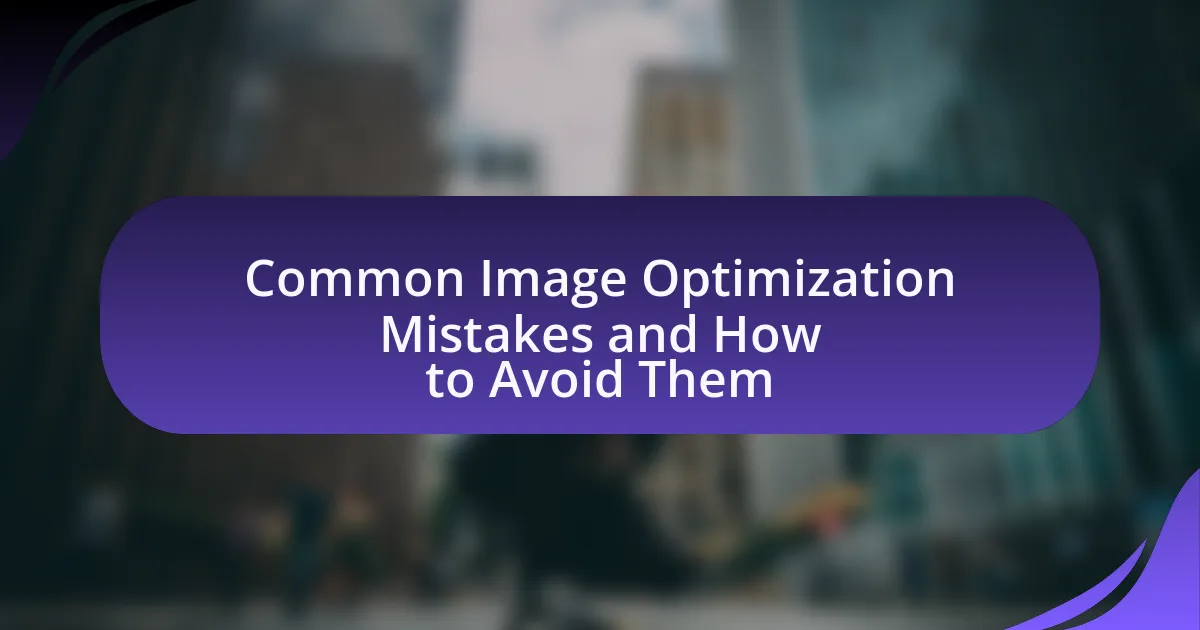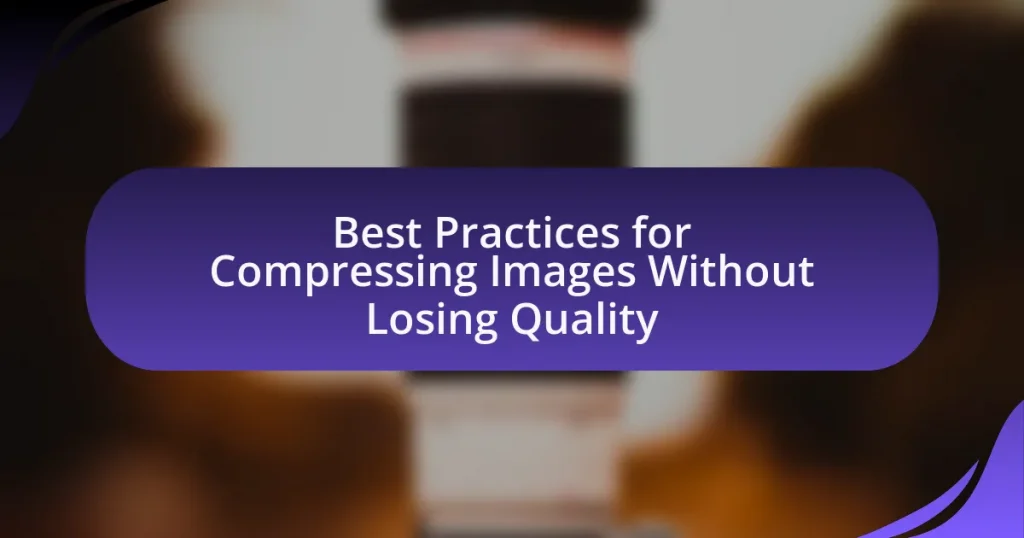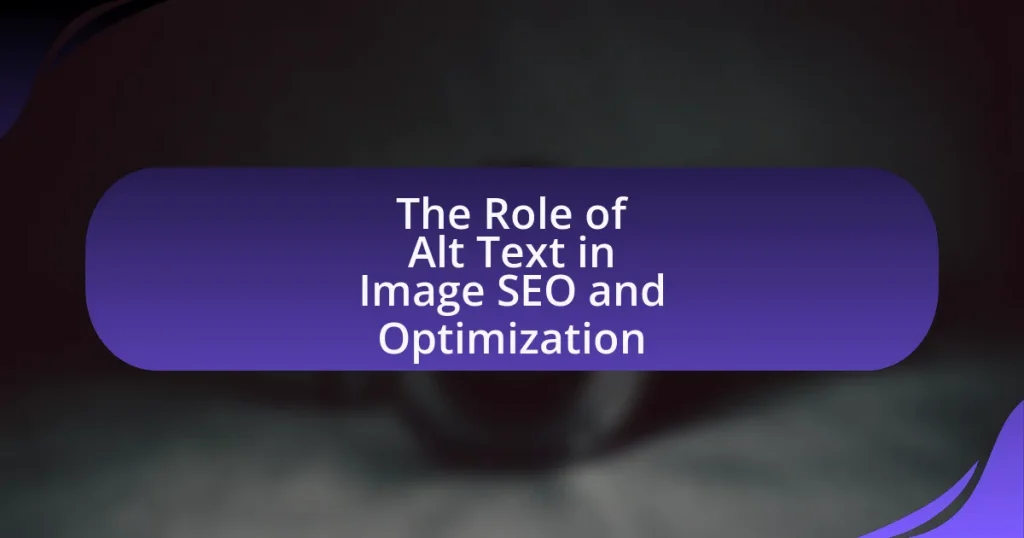The article focuses on common image optimization mistakes and strategies to avoid them, emphasizing the importance of proper image handling for website performance and user experience. Key mistakes include using uncompressed images, selecting inappropriate file formats, and neglecting responsive design, all of which can lead to slower loading times and negatively impact SEO rankings. The article outlines the significance of image optimization in enhancing website speed, reducing bounce rates, and improving user engagement, while also providing practical tools and best practices for effective image management. Additionally, it highlights the role of alt text for accessibility and SEO, and offers troubleshooting tips for common image display issues.
What are Common Image Optimization Mistakes?
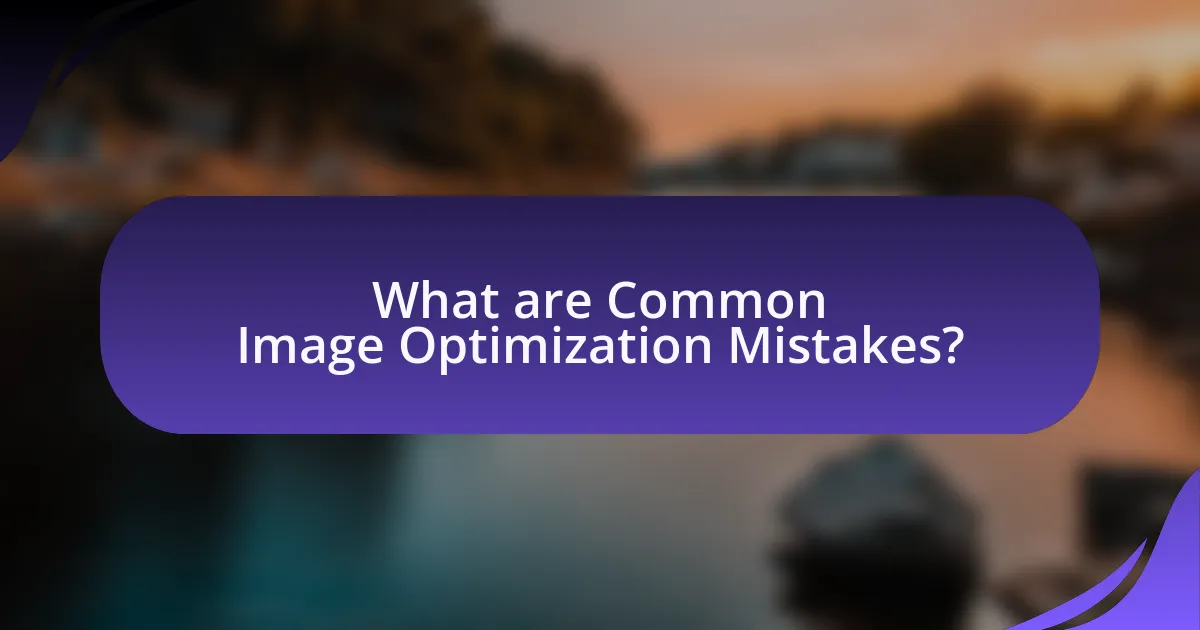
Common image optimization mistakes include using uncompressed images, neglecting to choose the right file format, and failing to implement responsive images. Uncompressed images can significantly slow down website loading times, negatively impacting user experience and SEO rankings. Choosing the wrong file format, such as using PNG for photographs instead of JPEG, can lead to unnecessarily large file sizes. Additionally, not using responsive images can result in poor display on various devices, further hindering performance. These mistakes can be avoided by employing proper compression techniques, selecting appropriate formats based on image type, and utilizing responsive design practices.
Why is Image Optimization Important?
Image optimization is important because it enhances website performance and user experience. Optimized images reduce file sizes, leading to faster loading times, which is crucial as studies show that a one-second delay in page load time can result in a 7% reduction in conversions. Additionally, search engines prioritize fast-loading sites, improving search rankings. Therefore, effective image optimization directly impacts both user engagement and SEO performance.
How does image optimization impact website performance?
Image optimization significantly enhances website performance by reducing file sizes, which leads to faster loading times. Faster loading times improve user experience, decrease bounce rates, and can positively impact search engine rankings. According to Google, a one-second delay in mobile load times can lead to a 20% decrease in conversions. Additionally, optimized images consume less bandwidth, which is crucial for users with limited data plans or slower internet connections. Therefore, effective image optimization is essential for maintaining a high-performing website.
What role does image optimization play in user experience?
Image optimization significantly enhances user experience by improving website loading speed and visual quality. Faster loading times reduce bounce rates, as studies show that a one-second delay can lead to a 7% reduction in conversions. Additionally, optimized images maintain high visual quality while minimizing file size, ensuring that users have a seamless and engaging experience. This balance between speed and quality is crucial, as 53% of mobile users abandon sites that take longer than three seconds to load. Therefore, effective image optimization directly contributes to higher user satisfaction and retention.
What are the most frequent mistakes in image optimization?
The most frequent mistakes in image optimization include using images that are too large, neglecting to use appropriate file formats, failing to compress images, and not utilizing alt text. Large images can significantly slow down website loading times, negatively impacting user experience and SEO; studies show that a 1-second delay in page load time can lead to a 7% reduction in conversions. Using inappropriate file formats, such as BMP instead of JPEG or PNG, can result in unnecessarily large file sizes. Additionally, neglecting to compress images can lead to wasted bandwidth and slower load times; tools like TinyPNG can reduce image sizes without sacrificing quality. Lastly, not including alt text misses an opportunity for better accessibility and SEO, as search engines rely on this text to understand image content.
How does using the wrong file format affect image quality?
Using the wrong file format can significantly degrade image quality by introducing compression artifacts, reducing color fidelity, and limiting resolution. For instance, using a lossy format like JPEG for images that require high detail can result in visible pixelation and blurring, especially when the image is enlarged or edited. Conversely, using a format like PNG for photographs can lead to unnecessarily large file sizes without any quality benefit, as PNG is better suited for images with fewer colors or transparency. Studies show that JPEG compression can reduce image quality by up to 50% compared to lossless formats like TIFF, which maintain original detail and color accuracy. Therefore, selecting the appropriate file format is crucial for preserving image quality.
What happens when images are not compressed properly?
When images are not compressed properly, they can lead to increased file sizes, resulting in slower loading times for websites. Larger images consume more bandwidth, which can negatively impact user experience and lead to higher bounce rates. Studies show that a 1-second delay in page load time can result in a 7% reduction in conversions, highlighting the importance of proper image compression for maintaining website performance and user engagement.
Why is neglecting alt text a common oversight?
Neglecting alt text is a common oversight because many content creators prioritize visual aesthetics over accessibility. This often leads to a lack of awareness regarding the importance of alt text for users with visual impairments, as well as for search engine optimization. Research indicates that approximately 1 in 5 people in the U.S. have a disability, highlighting the necessity of alt text for inclusivity. Furthermore, search engines utilize alt text to understand image content, which can impact website ranking. Thus, the combination of aesthetic focus and insufficient knowledge about accessibility contributes to the frequent neglect of alt text.
How Can You Identify Image Optimization Mistakes?

You can identify image optimization mistakes by analyzing image file sizes, formats, and dimensions in relation to web performance. Large file sizes can slow down page load times, while inappropriate formats (like using PNG for simple images) can lead to unnecessary bloat. Additionally, images that are not properly sized for their display context can cause layout shifts and affect user experience. Tools such as Google PageSpeed Insights and GTmetrix provide insights into image optimization, highlighting specific images that require adjustments.
What tools can help analyze image optimization?
Tools that can help analyze image optimization include Google PageSpeed Insights, GTmetrix, and ImageOptim. Google PageSpeed Insights evaluates the performance of web pages, providing insights on image loading times and suggestions for optimization. GTmetrix offers detailed reports on page speed and performance, highlighting areas where images can be optimized for faster loading. ImageOptim focuses specifically on compressing images without losing quality, making it easier to analyze and improve image file sizes. These tools are widely recognized for their effectiveness in enhancing image optimization strategies.
How do online tools compare in assessing image optimization?
Online tools for assessing image optimization vary in their capabilities, accuracy, and user experience. Some tools provide detailed analysis of image size, format, and loading speed, while others focus on specific metrics like compression levels or alt text usage. For instance, tools like Google PageSpeed Insights and GTmetrix offer comprehensive reports that include recommendations for improving image performance, whereas simpler tools may only provide basic size comparisons. The effectiveness of these tools is often validated by their ability to integrate with web performance metrics, demonstrating their relevance in optimizing images for faster loading times and better user experience.
What metrics should you focus on when evaluating images?
When evaluating images, focus on metrics such as resolution, file size, compression ratio, color accuracy, and loading time. Resolution determines the clarity and detail of an image, with higher resolutions generally providing better quality. File size impacts loading speed and bandwidth usage; smaller sizes are preferable for web use. Compression ratio indicates how much an image has been reduced in size while maintaining quality, with optimal ratios balancing quality and performance. Color accuracy ensures that the colors in the image are true to life, which is crucial for visual appeal. Finally, loading time affects user experience; images should load quickly to retain viewer engagement. These metrics collectively contribute to effective image optimization, enhancing both performance and visual quality.
How can you spot specific optimization errors?
You can spot specific optimization errors by analyzing image file sizes, loading times, and visual quality. Tools like Google PageSpeed Insights and GTmetrix provide metrics that highlight issues such as oversized images or improper formats. For instance, if an image takes longer than three seconds to load, it may indicate that the file size is too large or the format is not optimized for web use. Additionally, checking for missing alt text and ensuring images are responsive can reveal optimization errors that affect accessibility and user experience.
What signs indicate that images are slowing down your site?
Signs that indicate images are slowing down your site include increased page load times, high bounce rates, and poor user engagement metrics. When images are not optimized, they can significantly increase the time it takes for a webpage to fully load, often exceeding the recommended load time of three seconds. According to Google, a one-second delay in mobile load times can lead to a 20% decrease in conversions. Additionally, if analytics show that users are leaving the site quickly after arrival, it may suggest that slow-loading images are contributing to a negative user experience.
How can you determine if images are properly sized?
To determine if images are properly sized, check their dimensions against the display requirements of the platform where they will be used. Properly sized images should match the pixel dimensions specified for web pages, social media, or print media, ensuring they load quickly and maintain quality. For example, a website may require images to be 1200×800 pixels for optimal display; images exceeding this size may slow down loading times, while those smaller may appear pixelated. Additionally, tools like image editing software or online image resizers can help verify and adjust image dimensions to meet these specifications.
What Strategies Can Help Avoid Image Optimization Mistakes?
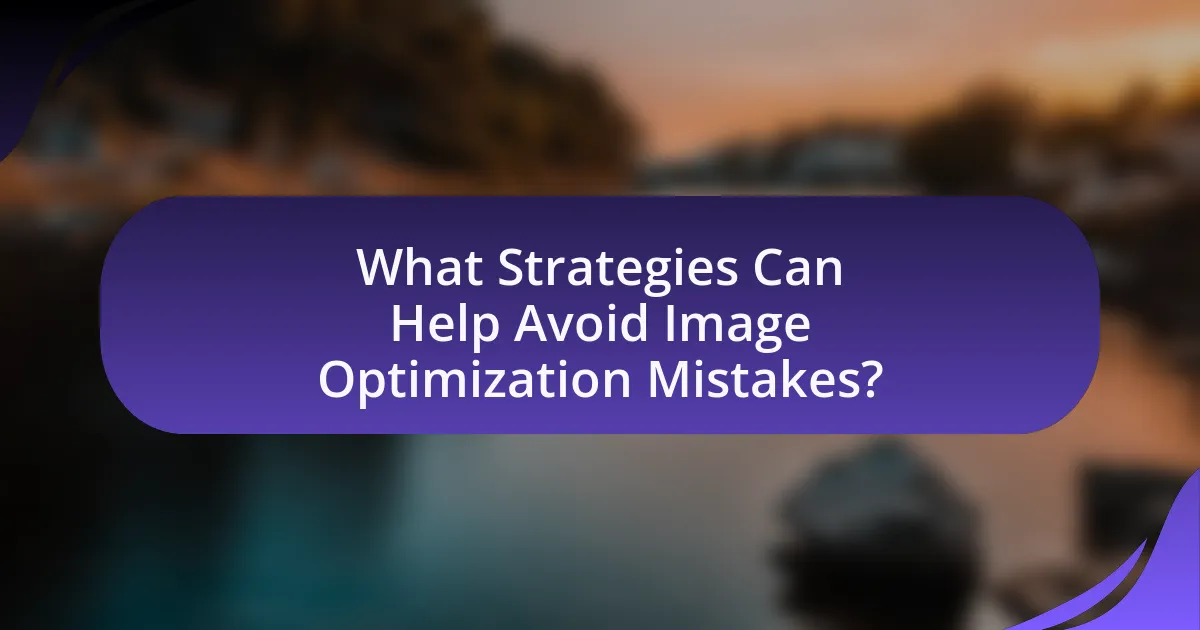
To avoid image optimization mistakes, implement strategies such as using appropriate file formats, compressing images without losing quality, and utilizing descriptive file names and alt text. Selecting the right file format, like JPEG for photographs and PNG for graphics, ensures optimal quality and loading speed. Compressing images using tools like TinyPNG or ImageOptim can reduce file size while maintaining visual integrity, which is crucial for website performance. Additionally, descriptive file names and alt text enhance SEO and accessibility, making images more discoverable and usable. These strategies collectively improve user experience and search engine rankings, validating their importance in effective image optimization.
What best practices should you follow for image optimization?
To optimize images effectively, follow these best practices: use appropriate file formats, compress images without losing quality, and implement responsive images. Using formats like JPEG for photographs and PNG for graphics ensures optimal quality and file size. Compression tools such as TinyPNG or ImageOptim can reduce file sizes significantly, often by 50% or more, while maintaining visual integrity. Additionally, employing responsive images through HTML attributes like ‘srcset’ allows images to adapt to different screen sizes, enhancing user experience and loading times. These practices collectively improve website performance and SEO rankings.
How can you choose the right file format for different images?
To choose the right file format for different images, consider the purpose and characteristics of the image. For photographs with rich colors and gradients, use JPEG, which offers good compression and quality balance. For images requiring transparency or sharp edges, such as logos, use PNG, which supports lossless compression and transparency. For vector graphics, SVG is ideal as it maintains quality at any size. Additionally, TIFF is suitable for high-quality prints due to its lossless nature, though it results in larger file sizes. These choices are based on the specific needs of the image, such as quality, transparency, and file size considerations.
What are effective methods for compressing images without losing quality?
Effective methods for compressing images without losing quality include using lossless compression algorithms, such as PNG or TIFF formats, and employing tools like ImageOptim or TinyPNG. Lossless compression retains all original image data, ensuring no quality degradation occurs. Additionally, utilizing vector graphics for images that can be represented in this format, such as logos and icons, allows for infinite scalability without loss of quality. Furthermore, adjusting image dimensions to the required display size before compression can significantly reduce file size while maintaining visual integrity. These methods are widely recognized in the field of digital imaging and are supported by various software solutions that prioritize quality preservation during the compression process.
How can you ensure consistent image optimization?
To ensure consistent image optimization, implement a standardized process that includes specific guidelines for image formats, sizes, and compression levels. Establishing a set of criteria for each image type helps maintain uniformity across all visual content. For instance, using JPEG for photographs and PNG for graphics with transparency can optimize quality while minimizing file size. Additionally, utilizing tools like ImageMagick or TinyPNG can automate the compression process, ensuring that images are consistently optimized without sacrificing quality. Studies show that optimized images can improve website loading times by up to 70%, enhancing user experience and SEO performance.
What tools can automate image optimization processes?
Tools that can automate image optimization processes include ImageMagick, TinyPNG, and Kraken.io. ImageMagick is a powerful command-line tool that allows batch processing of images, enabling users to resize, convert, and optimize images efficiently. TinyPNG uses smart lossy compression techniques to reduce file sizes without significantly affecting image quality, making it ideal for web use. Kraken.io offers both a web interface and an API for image optimization, providing features like lossless and lossy compression, as well as image resizing. These tools are widely recognized for their effectiveness in streamlining image optimization tasks, thus helping to avoid common mistakes such as excessive file sizes that can slow down website performance.
How can you create a checklist for image optimization?
To create a checklist for image optimization, identify key factors such as image format, size, resolution, and alt text. Start by selecting the appropriate image format (e.g., JPEG for photographs, PNG for graphics with transparency) to ensure quality and loading speed. Next, compress images to reduce file size without sacrificing quality, aiming for a balance that maintains visual integrity while improving load times. Ensure images have the correct resolution for their intended use, typically 72 DPI for web and 300 DPI for print. Finally, include descriptive alt text for accessibility and SEO benefits. This structured approach helps avoid common mistakes like using large file sizes or incorrect formats, which can hinder website performance.
What are some common troubleshooting tips for image optimization?
Common troubleshooting tips for image optimization include checking image file formats, ensuring proper compression levels, and verifying dimensions. Using appropriate file formats like JPEG for photographs and PNG for graphics can significantly enhance loading times and quality. Additionally, applying the right compression techniques, such as lossless or lossy compression, can reduce file sizes without compromising visual fidelity. Finally, confirming that images are not larger than necessary for their display size prevents excessive loading times, which is crucial for user experience and SEO performance.
How can you quickly fix images that are not displaying correctly?
To quickly fix images that are not displaying correctly, first check the image file path to ensure it is correct and accessible. If the path is incorrect, update it to point to the correct location. Additionally, verify that the image format is supported by the browser; common formats include JPEG, PNG, and GIF. If the format is unsupported, convert the image to a compatible format. Furthermore, inspect the HTML or CSS code for any errors that may prevent the image from loading, such as missing tags or incorrect styles. These steps are effective because they address the most common issues that lead to image display problems, ensuring that images load properly on web pages.
What steps should you take if images are still too large after optimization?
If images are still too large after optimization, you should consider further reducing their dimensions, changing the file format, or applying additional compression techniques. Reducing dimensions involves resizing the image to the exact display size needed, which can significantly decrease file size. Changing the file format to more efficient types like WebP or AVIF can also help, as these formats provide better compression without sacrificing quality. Additionally, using advanced compression tools such as TinyPNG or ImageOptim can yield further size reductions. These methods are supported by various studies indicating that optimized images can improve website loading times and user experience, with research showing that images can account for up to 70% of a webpage’s load time.
